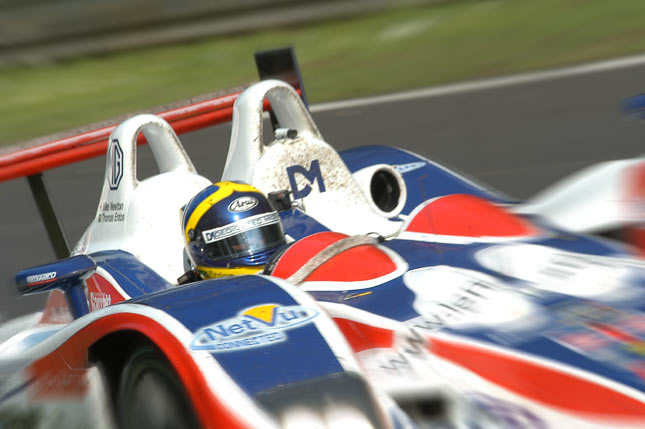Le
Mans Series 2007
Round 2. Monza 1000 Kilometers. April 13th-15th 2007
Sunday
Report
Warm
Up
Race
day began with official warm-up at nine o’clock. Bright,
clear skies and strong sunshine quickly lifted the overnight
chill, and track conditions were excellent as the first
cars started queuing up at the pitlane exit. The RML MG
stayed on the airjacks directly outside the team garage,
Thomas Erdos strapped into the cockpit, waiting until the
lights actually changed to green before the team fitted
the pre-warmed tyres.
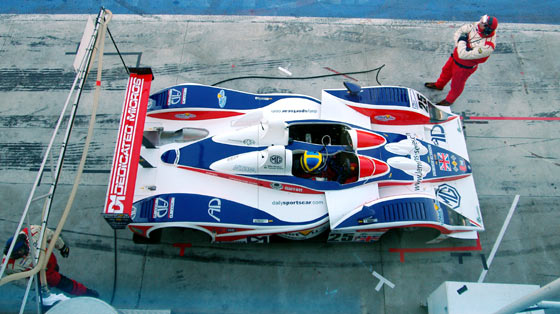
There
has still been no official announcement regarding the exclusion
of the Quifel ASM Lola from yesterday’s qualifying
results, although the paddock understands that the wooden
plank which is fitted to the underside of every car proved
to be fractionally thinner than the regulations permit –
the result of excessive wear around the Monza circuit, thanks
largely to unevenness in the track surface. Evidently with
a point to prove, therefore, de Castro was eager to demonstrate
the car’s pace once again, and the #40 Lola quickly
topped the LMP2 timing screen.
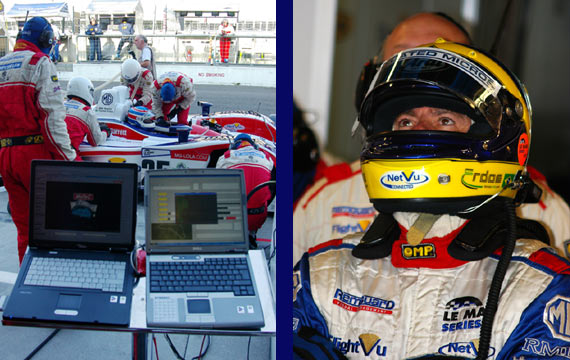
Also
showing good pace was Karim Ojeh in the Barazi Epsilon Zytek,
but times in general were significantly slower than they
had been in qualifying. Tommy’s fifth and final lap
was his quickest, at 1:42.435, and brought all three P2
class leaders to within half a second of each other. With
that achieved, he pitted the MG and handed over controls
to Mike Newton, who completed the final quarter-hour of
the thirty-minute session.
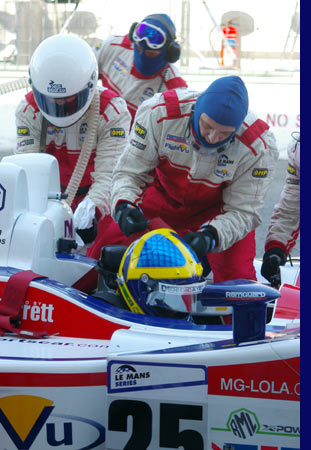 In
the closing moments de Castro threw in a 1:41, but times
set in warm-up are rarely representative, with most teams
simply using the brief session to test final adjustments
and to assess race set-up. That was certainly the case in
the RML garage, where the car ran in full race trim, and
once Mike Newton had came back to the garage to complete
the session, the team carried out a simulated driver change.
Mike climbed out of the car, Erdos settled back in again,
and the rest of the crew carried out a full wheel change
and refuelling run-through.
In
the closing moments de Castro threw in a 1:41, but times
set in warm-up are rarely representative, with most teams
simply using the brief session to test final adjustments
and to assess race set-up. That was certainly the case in
the RML garage, where the car ran in full race trim, and
once Mike Newton had came back to the garage to complete
the session, the team carried out a simulated driver change.
Mike climbed out of the car, Erdos settled back in again,
and the rest of the crew carried out a full wheel change
and refuelling run-through.
It
was a slick demonstration (left), and watched with
interest by the nearby teams. What the process illustrated
all too well is just how cramped the pitlane facilities
are at Monza, where the garages are significantly narrower
than a car’s length. If adjacent teams arrive simultaneously,
then space is at a premium, and it becomes even more vital
that pitlane and crew discipline is observed. The organisers
have tied to anticipate this by mixing the categories down
the pitlane, and if fuel strategies run according to plan,
then cars from adjacent garages should rarely arrive at
the same time. A safety car period could alter all that,
of course.
The
MG was hauled back into the garage. “That went exactly
to plan,” smiled a satisfied Mike Newton. “The
car is very comfortable now, and we’re exactly where
we wanted to be. We’re all looking forward to the
race now.”
In the meantime, a succession of support races were run,
including the Peugeot 207 Cup and the Renault World Series
single-seaters.
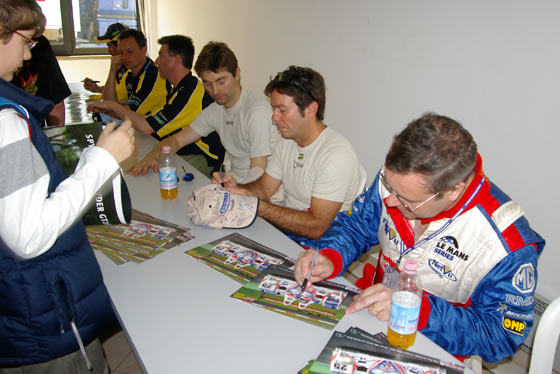
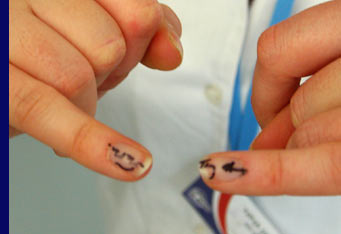 While
these other events were taking place, the Le Mans Series
drivers took part in a combined autograph session, staged
in one of the paddock buildings.
While
these other events were taking place, the Le Mans Series
drivers took part in a combined autograph session, staged
in one of the paddock buildings.
Nearly
every driver attended, with Mike Newton and Thomas Erdos
having the newly published 2007 RML HeroCards to sign. Given
the opportunity, however, they'll sign almost anything!
(That's "Mike Newton" on the left, and "Tommy
Erdos" on the right)
Back
to Top
Race
Start
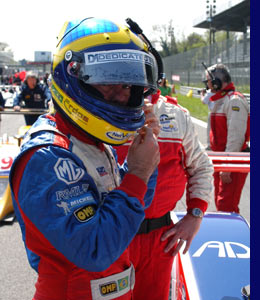 With
conditions more reminiscent of a balmy summer’s day,
the forty-six starters for the opening round of the 2007
Le Mans Series, took up their places on the baked tarmac
of Monza’s historic Autodroma. At least three cars
would start from the pitlane, following delays and problems
arising from the morning warm-up, including the Rollcentre
LMP1 Pescarolo and the Pierre Bruneau Pilbeam. Another prototype
moved out of sequence for the start was the Quifel ASM Lola,
which had been relegated to the back of the grid –
from class pole – after the wooden plank that acts
as an undertray on all cars was discovered to have worn
one millimetre thinner than regulations allow. While the
cars took up their positions on the grid, a fuel leak was
discovered on the equally speedy Barazi Epsilon Zytek, and
it was immediately removed to the garage so that the team
could attempt a repair.
With
conditions more reminiscent of a balmy summer’s day,
the forty-six starters for the opening round of the 2007
Le Mans Series, took up their places on the baked tarmac
of Monza’s historic Autodroma. At least three cars
would start from the pitlane, following delays and problems
arising from the morning warm-up, including the Rollcentre
LMP1 Pescarolo and the Pierre Bruneau Pilbeam. Another prototype
moved out of sequence for the start was the Quifel ASM Lola,
which had been relegated to the back of the grid –
from class pole – after the wooden plank that acts
as an undertray on all cars was discovered to have worn
one millimetre thinner than regulations allow. While the
cars took up their positions on the grid, a fuel leak was
discovered on the equally speedy Barazi Epsilon Zytek, and
it was immediately removed to the garage so that the team
could attempt a repair.
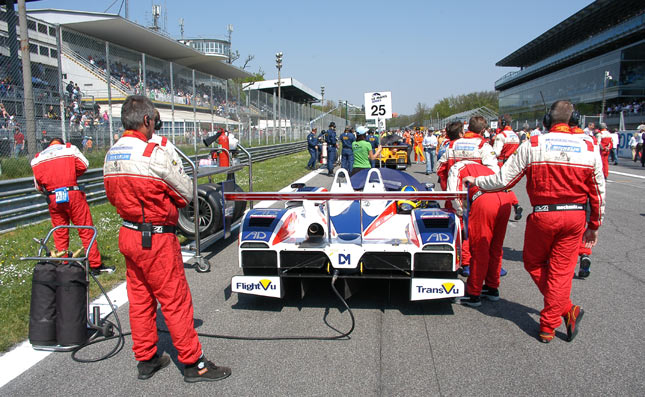
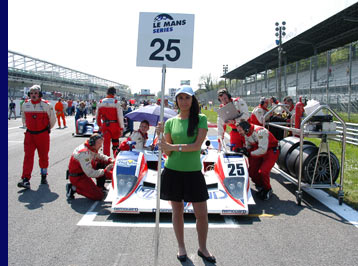 The
departure of both the ASM Lola and the Barazi Zytek effectively
placed Thomas Erdos on LMP2 pole. The MG Lola had been unbeaten
in qualifying throughout 2006, maintaining a clean sheet
of poles throughout the Le Mans Series and the Le Mans 24
Hours . . . but can Monza now be added to the unbroken record?
No doubt the statisticians will debate the issue!
The
departure of both the ASM Lola and the Barazi Zytek effectively
placed Thomas Erdos on LMP2 pole. The MG Lola had been unbeaten
in qualifying throughout 2006, maintaining a clean sheet
of poles throughout the Le Mans Series and the Le Mans 24
Hours . . . but can Monza now be added to the unbroken record?
No doubt the statisticians will debate the issue!
In
front of one of the best crowds seen at a Le Mans Series
race since Spa last year, the massive grid of prototypes
and GT cars set off on the 5.7 kilometre parade lap at just
before one o’clock. The grandstands through the first
and Ascari chicanes, and around the famous Parabolica, were
generously packed with spectators, while only the main grandstand
opposite the pits looked sparsely populated – that
aside, a sign that local advertising had worked. Poster
bearing images of the RML MG were dotted all around Milan!
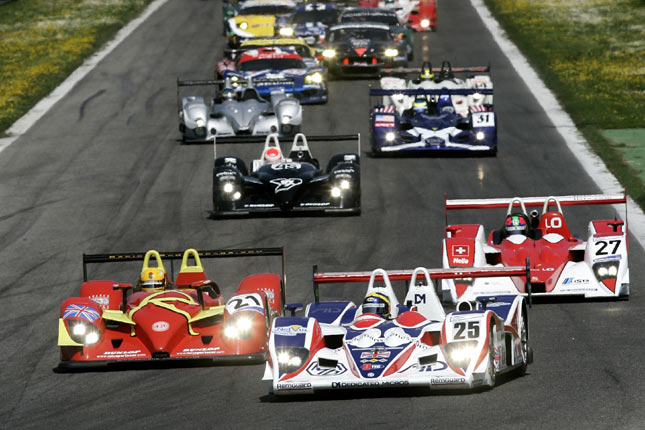
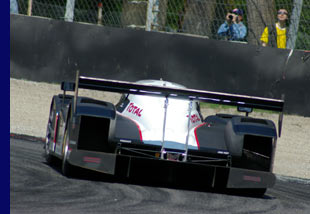 At
four minutes past one, the assembled cars finally blasted
across the line to start the Monza 1000 kilometers. 173
laps of the track or six hours, whichever came first, and
with the pace being shown by the polesetting Peugeots, there
seemed every chance that this time the race would go the
distance. Those Peugeots pulled away immediately, with only
the Cheroz Lola seemingly able to hang on to their elegant
tails. A little way back, however, there was the usual mad
scramble for the first of Monza’s speed-sapping chicanes.
Despite the prospect of several hours racing ahead of them,
a fair few drivers were taking no prisoners as they bottlenecked
down towards the tightening first corner. One of those peering
through a red mist was Stuart Moseley in the Bruichladdich
Radical, who elbowed his way alongside Erdos, thumping into
the side of the MG at least three times on the run down
to the bend. Wise head on shrugging shoulders, Erdos left
him to it, and slotted in behind the orange car as they
wove their way through the esses (below). “That
was a totally unnecessary risk,” said a bewildered
Erdos later. “It was completely ridiculous to attempt
a move like that right at the start of a six hour race.
I really don’t know what he thought he was doing .
. . and he’s a friend of mine! He risked both cars,
and for what? Nothing!”
At
four minutes past one, the assembled cars finally blasted
across the line to start the Monza 1000 kilometers. 173
laps of the track or six hours, whichever came first, and
with the pace being shown by the polesetting Peugeots, there
seemed every chance that this time the race would go the
distance. Those Peugeots pulled away immediately, with only
the Cheroz Lola seemingly able to hang on to their elegant
tails. A little way back, however, there was the usual mad
scramble for the first of Monza’s speed-sapping chicanes.
Despite the prospect of several hours racing ahead of them,
a fair few drivers were taking no prisoners as they bottlenecked
down towards the tightening first corner. One of those peering
through a red mist was Stuart Moseley in the Bruichladdich
Radical, who elbowed his way alongside Erdos, thumping into
the side of the MG at least three times on the run down
to the bend. Wise head on shrugging shoulders, Erdos left
him to it, and slotted in behind the orange car as they
wove their way through the esses (below). “That
was a totally unnecessary risk,” said a bewildered
Erdos later. “It was completely ridiculous to attempt
a move like that right at the start of a six hour race.
I really don’t know what he thought he was doing .
. . and he’s a friend of mine! He risked both cars,
and for what? Nothing!”
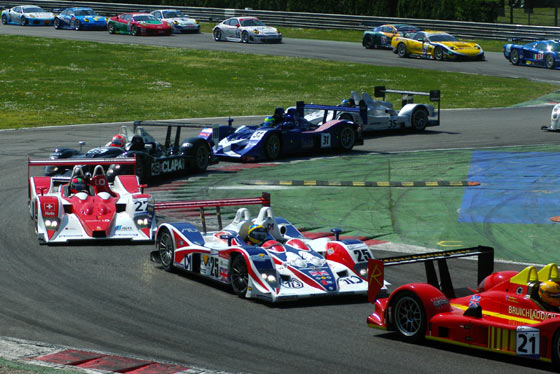
Beyond the chicane the track opens out again into the fast
run to the Curva Biassono – a fast right-hander –
that gathers pace until the second chicane is reached, effectively
restricting entry speeds into the challenging two-part Lesmo.
By the time the LMP2 leaders reached this point, however,
it was already apparent that Moseley had a problem. Inside
forty seconds, a connecting hose on the Radical’s
turbo had blown, and the car’s race was over. It would
manage a second slow lap before retiring. The old adage
of “more haste, less speed” comes to mind.
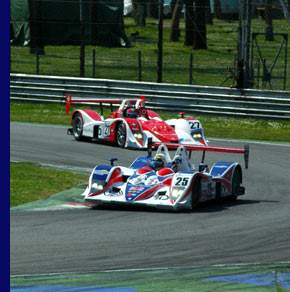 With
Moseley gone, Erdos calmly regained the lead, and proceeded
to ease away from the Eric van de Poele in the Horag Lola
#27. The Embassy Radical, with former RML driver Warren
Hughes at the wheel, had started well, and held third for
a short while, but was trundling down the pitlane at the
end of the first lap with a gear selection problem. This
left the Binnie Lola third and the #35 Saulnier Courage
fourth, although these two would soon swap places, and thereby
establish a top three in LMP2 that bore little resemblance
to expectations – save that Thomas Erdos was leading.
With
Moseley gone, Erdos calmly regained the lead, and proceeded
to ease away from the Eric van de Poele in the Horag Lola
#27. The Embassy Radical, with former RML driver Warren
Hughes at the wheel, had started well, and held third for
a short while, but was trundling down the pitlane at the
end of the first lap with a gear selection problem. This
left the Binnie Lola third and the #35 Saulnier Courage
fourth, although these two would soon swap places, and thereby
establish a top three in LMP2 that bore little resemblance
to expectations – save that Thomas Erdos was leading.
The
Barazi Epsilon Zytek, with Michael Vergers sitting patiently
in the cockpit, would fail to make the one-hour cut. If
a car cannot start the race within sixty minutes, it is
excluded from the race. Unable to rectify the fuel leak
in time, the French car, with its distinctive pastel blue
and orange Gulf livery, never emerged from the garage.
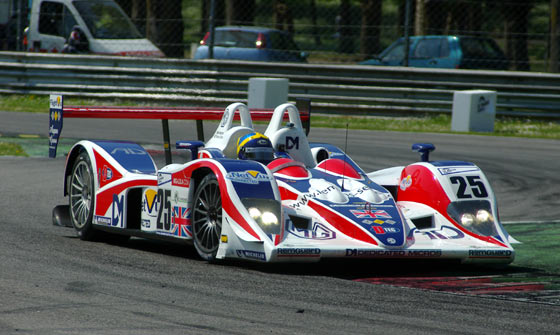
With
all but one of its principal rivals already encountering
difficulties, prospects for the RML MG Lola suddenly started
to look far more straightforward. Nearer the back of the
field, however, Miguel de Castro in the ASM Lola was making
rapid progress through the tail-end, despite his last-place
start. In response, Thomas Erdos was not holding back either,
and on lap three he set a time of 1:42.268 that would stand
unchallenged for the remainder of the race. Establishing
a new lap LMP2 record for the Monza circuit demonstrated
once again how preparation for the race, rather than just
a quick lap in qualifying, is the way to go in endurance
motorsport.
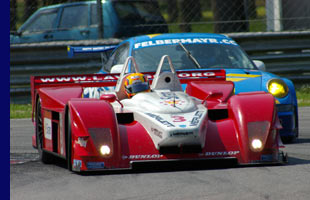 A
quarter of an hour into the race and Tommy’s lead
had extended to more than eight seconds, with the Horag
Lola second, the Saulnier Courage third, and the Binnie
Motorsports Lola falling back in fourth. Right out at the
front, the two LMP1 Peugeots had eased clear of the Charouz
Lola, but were still circulating as a close-knit pair. Also
running better than its practice and qualifying performances
might have suggested was the Lavaggi LMP1 prototype (right)
– a brave attempt by one man to design and build his
own racecar, much against the odds. The car would encounter
mechanical difficulties later, but for now at least, was
holding its own in good company. Another running well was
Joao Barbosa in the Rollcentre Pescarolo, who had moved
through to 14th overall from the back of the grid.
A
quarter of an hour into the race and Tommy’s lead
had extended to more than eight seconds, with the Horag
Lola second, the Saulnier Courage third, and the Binnie
Motorsports Lola falling back in fourth. Right out at the
front, the two LMP1 Peugeots had eased clear of the Charouz
Lola, but were still circulating as a close-knit pair. Also
running better than its practice and qualifying performances
might have suggested was the Lavaggi LMP1 prototype (right)
– a brave attempt by one man to design and build his
own racecar, much against the odds. The car would encounter
mechanical difficulties later, but for now at least, was
holding its own in good company. Another running well was
Joao Barbosa in the Rollcentre Pescarolo, who had moved
through to 14th overall from the back of the grid.
Five
minutes later and de Castro had battled his way through
to fifth in LMP2, although the early loss of so many other
cars from the category probably made this an easier task
than it might otherwise have been. The Embassy Radical was
also back on track, Warren Hughes rejoining immediately
ahead of Thomas Erdos, albeit many laps down the order.
Tommy powered by on the exit of the first chicane, although
Warren would post a very creditable 1:42.537, thereby confirming
that, when sorted, the Radical will be a serious contender
in the series.
By
half-one, Barbosa’s charge in the LMP1 Pescarolo had
brought him onto the MG’s tail, and he eased ahead
of the LMP2 leader down the main straight, leaving Erdos
to enjoy a 17 second lead over the #27 Lola. The ASM Lola’s
charge from the back persisted, with de Castro through into
third with a pass on the #35 Courage at just gone 1:35pm.
His progress had been made easier when the #31 Binnie Lola
developed a cooling problem and had to pit for repairs to
a radiator hose, while Embassy’s woes persisted; the
paddle-shift system sending Hughes back to the garage once
again.
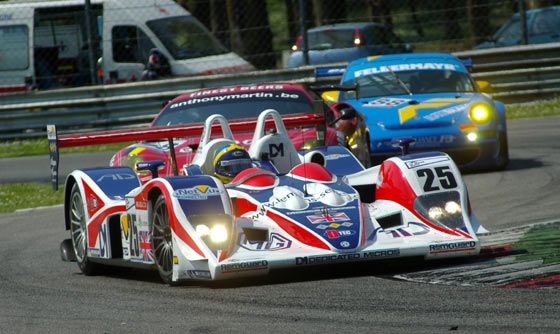
All
Erdos’s hard work would be for nothing a short while
later when Steve Zacchia’s DBR9 Aston Martin lost
a wheel going into the Ascari chicane. The car spun wildly,
and ended up facing the wrong way in the middle of the track.
The organisers had no option but to deploy the safety car,
and it took some while for the leader to be collected. In
the meantime, the field bunched up, but not before the Binnie
Lola had rejoined – conveniently positioned between
the Horag and ASM Lolas. It was a clean sweep of front-runners
in LMP2 for the Huntingdon manufacturer, and when the green
flags were waved at ten-to-two, Tommy was able to pull away
somewhat from the Horag car, while de Castro was delayed,
if only briefly, by the #31.
Hours
2-3
As
the first hour drew to a close, and both Radicals made another
brief appearance (the Bruichladdich car for just one lap,
the Embassy for a bit longer) Tommy brought the MG down
the pitlane for its first scheduled pitstop for fuel and
tyres. It was a characteristically slick operation, but
any delay at this early stage of a race invariably costs
track position, so there was no surprise when the MG emerged
to find the ASM Lola leading. Eric van de Poele had also
pitted in the Horag Lola, but his stop was not as quick.
When de Castro pitted on the following lap, a speedier effort
by the Portuguese crew would see the grey and blue car resume
just ahead of the Swiss car. The MG still lead, but the
ASM Lola was now second with Horag third.
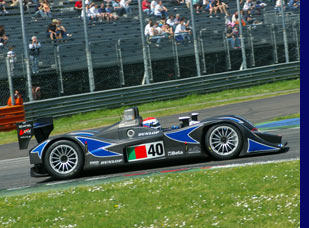 That
was how the race stood for the next hour too. The MG steadily
regained some of its earlier buffer, Erdos usually posting
quicker times than de Castro (left), despite what
might have been implied by qualifying and practice, and
by half-past the gap had grown to around 12 seconds. At
that stage the RML #25 stood ninth overall, leading LMP2,
but as the second hour drew to a close, Erdos had moved
through to 5th. His advantage over de Castro had grown to
an impressive 30 seconds and, just to emphasise the point,
the Brazilian then set his fastest first two sectors of
the race. Was another record on the cards? No, he was simply
gearing up for the in-lap, and seconds later the MG’s
AER two-litre turbo was making that distinctive staccato
flutter as Erdos brought the car down the pitlane on the
rev limiter.
That
was how the race stood for the next hour too. The MG steadily
regained some of its earlier buffer, Erdos usually posting
quicker times than de Castro (left), despite what
might have been implied by qualifying and practice, and
by half-past the gap had grown to around 12 seconds. At
that stage the RML #25 stood ninth overall, leading LMP2,
but as the second hour drew to a close, Erdos had moved
through to 5th. His advantage over de Castro had grown to
an impressive 30 seconds and, just to emphasise the point,
the Brazilian then set his fastest first two sectors of
the race. Was another record on the cards? No, he was simply
gearing up for the in-lap, and seconds later the MG’s
AER two-litre turbo was making that distinctive staccato
flutter as Erdos brought the car down the pitlane on the
rev limiter.
The
driver swap and refuel went without a hitch, and Mike Newton
rejoined in 8th position overall, second in P2 behind de
Castro. When the Quifel ASM Lola pitted two minutes later,
and de Castro handed over to Miguel Amaral, Newton regained
the class, revealing a thirty-second lead still intact.
It
was soon evident that Mike Newton, chief executive of the
AD Group and Gentleman Driver, was out to embarrass the
competition. Not only had he moved into 6th overall, but
he was gaining steadily on Gareth Evans in the #19 Chamberlain
Synergy LMP1 Lola in front of him. Behind him, the gap to
Amaral in the #40 ASM Lola was extending lap-by-lap, leaving
the Horag #27 Lola a distant third. All three were on the
same lap, but with Mike consistently setting lap times in
the 1:44 or 1:45 bracket, sometimes quicker, depending upon
traffic, it was unlikely to stay that way for long. With
all the rest typically two seconds a lap slower, the MG
clearly had the edge.
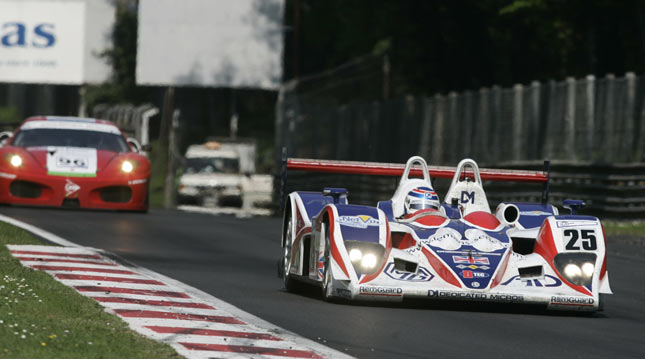
This
pace from Newton was all the more impressive when it later
became known that the MG was suffering from a severe vibration,
caused when the brand new tyres had picked up a large chunk
of waste rubber on the pitlane exit. For almost quarter
of an hour Mike drove with a vibration so brutal that, at
one time, he worried that the front suspension might give
way. “It was so bad I couldn’t see anything
at all in the mirrors,” he said. “It also made
it difficult to see the corners or judge braking points,
and every time I got over 120 or 140 clicks, it was almost
impossible to bear. Mind you, we’d also lost the dash
timing, so I really had no idea how fast I was going!”
Within
half an hour the gap to Amaral had extended to more than
40 seconds, and Mike was now catching the occasional glimpse
of Evans on the track ahead of him. Everything was going
smoothly at last, and the vibration had eased as the sticky
wrapping of spent rubber had steadily worn away. At 3:42,
the MG was back outside the RML garage for Mike’s
mid-stint scheduled pitstop (below). Fuel and tyre-change
completed, he was swiftly back in the action, having temporarily
lost the lead, but still ahead of the Horag car.
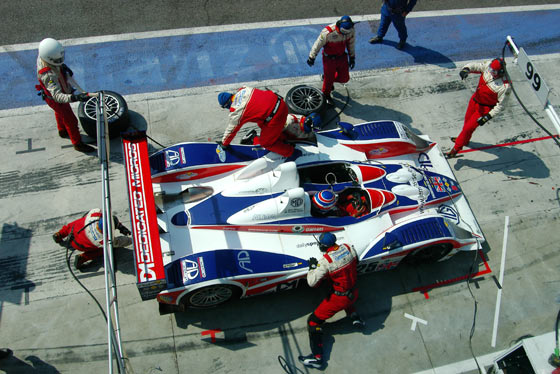
The
next “significant moment” in the race came five
minutes later, when Miguel Amaral brought the Quifel ASM
Lola hobbling back to the pits. The left rear wheel was
crabbing awkwardly, and what first appeared to be a puncture
was soon revealed as rear suspension failure. The Spaniard
managed to get the car back to the pits, but this was no
quick-fix situation, and the Lola was dragged back into
the garage for repairs.
Hour
4
As
the race entered its fourth hour Newton’s lead over
Didier Theys, now at the wheel of the Horag Lola, had grown
to more than a minute. The #35 Saulnier Racing Courage was
still holding third in class, but the silver car was two
laps down on Theys. There was no obvious sign of the ASM
Lola rejoining, as yet, and all the remaining LMP2 runners
had either fallen back with troubles, or never really made
an impression. At the sharp end of the race, Nic Minassian
had styeered the #7 Peugeot 908 into a two-lap lead over
Emanuel Collard in the #16 Pescarolo; the second Peugeot
having encountered gearbox and cockpit door delays. At 4:05,
Mike crossed the line to complete the MG's 100th lap, his
lead in LMP2 standing at 1 minute 28 seconds.
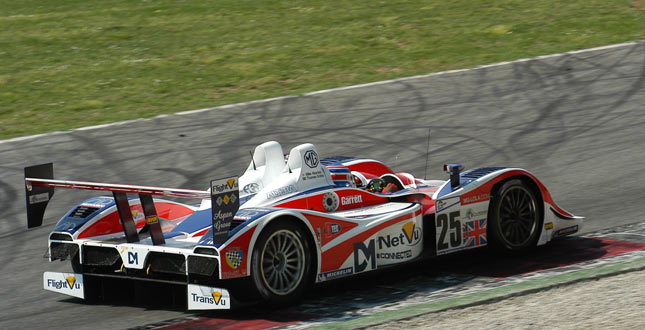
In
the early days of LMP2, the category earned a reputation
for fragility. Highly stressed, turbocharged engines in
lightweight chassis, pushed to extremes, tended to break
much too easily. By the end of 2006 that perception had
changed, and the class was enjoying a revival in fortunes
and reputation. However, with 60% of the 2007 Monza 1000
kilometres complete, only two of the ten LMP2 starters were
still untroubled; the leading MG EX264, and the chasing
Horag Lola. The #35 Courage had just pulled off into the
pits - reason unknown – and would remain there for
nearly twenty laps. For the time being it was still shown
as third in class, but Bill Binnie’s #31 Lola was
making a strong recovery after its earlier problems, and
would soon catch and overtake the Courage. Confirmation
came shortly afterwards that the ASM Lola would not be rejoining
either, and elsewhere the Embassy Radical’s woes continued,
as Niel Cunningham eased to a halt near Parabolica with
a dead engine.
While
all seemed to be going according to plan for RML, the first
hint of a possible problem for the MG had come with Newton’s
previous pitstop. The engine temperature was higher than
Team Manager Phil Barker would have liked, and rising. A
brief check had revealed no source for the loss of coolant,
and the system had been rapidly topped up. Just as Cunningham
was coasting to a halt in the Radical, Mike Newton was handing
the RML MG back to Thomas Erdos. Once again, the pitstop
was swift, with no obvious issues to the casual observer,
but once again the coolant level had been replenished. “Mike
effectively took over in the lead, and handed the car back
in the same position,” said an impressed Adam Wiseberg.
“That was an excellent performance.”
The
MG was rapidly on circuit once more, but the Horag Lola
had moved into the lead as a result of the pitstop, although
had yet to make its own scheduled refuel. The Binnie Motorsports
Lola, having begun its recovery, was lying fifth in class,
but 29th overall. With the stoppages for the #35 Courage
and the #40 Lola, Simon Pullan in the Pierre Bruneau Pilbeam
had moved through into third position in LMP2, albeit 23rd
overall. Having started the race from the pitlane, this
was no mean achievement for the French team.
So
Theys continued to lead the class, 8th overall, with Thomas
Erdos 9th. The gap between the two was holding pretty constant
as they traded laptimes through the traffic, with Erdos
having the slight edge but only able to nibble away small
chunks of the deficit. Like the proverbial swan, despite
his pace and fluid line, all was not quite as serene beneath
the surface. The on-board telemetry continued to remind
both driver and team that the coolant temperature was increasing
steadily, but what was of greater concern was the fact that
the rate of that rise was escalating. When the problem had
first been detected, the car had been able to run for eighteen
to twenty laps before it was deemed necessary to call Mike
in for a top-up. That interval was narrowing, and was now
down to about a dozen laps.
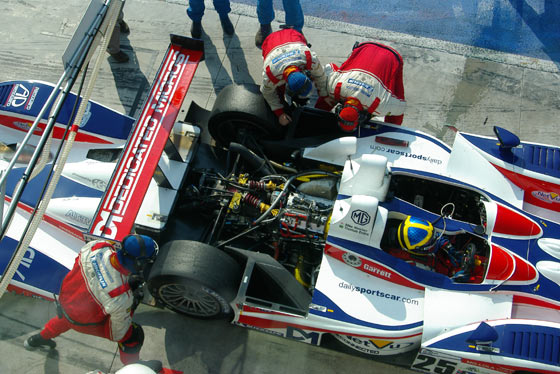
At
half-four Thomas Erdos brought the MG back to the garage,
and for the first time the covers came off (above).
“When the temperature got up to 106, Phil called me
back in again. It was undoubtedly the right thing to do.”
The radiator ducts were checked for debris, and the system
was examined for any sign of a leak. Nothing obvious was
found, and after a stop of probably less than two minutes,
the engine cover was replaced, the coolant levels were replenished,
and Tommy was waved on his way. “We looked, but couldn’t
find the leak,” admitted Phil Barker. “We decided
to press on, watching the telemetry, and re-filling the
system whenever we needed to.”
The
extra pitstop had not altered the overall standings, but
the gap to the Horag Lola had grown to almost two laps.
Even after Didier Theys had made his own pitstop five minutes
later, the red and white car was still leading comfortably.
Things were less comfortable for Gareth Evans on the #19
Chamberlain Synergy Lola. Having been under threat from
Newton only a short time previously, he had come to grief
at Parabolica, and buried the yellow Lola in the gravel.
“That’s just one of those things that happens
when you’re being chased down by a P2 car!”
suggested Mike Newton. In fact, it had been a good run from
the Chamberlain car, with the Lola rising to third overall
under pitstops, but when the car was dragged unceremoniously
behind the barriers it was only a matter of time before
both #27 Lola and Erdos in the MG would move ahead. At ten
to five, that happened, with the LMP2 leaders inheriting
7th and 8th overall as a result.
Hour
5
The
gap between Theys and Erdos stood at almost two laps, thanks
to the additional pitstop. At just after five o’clock
Erdos was back again. The team refueled the MG as normal,
and then topped up the coolant levels. It was a quick stop,
but the Horag Lola’s advantage extended nonetheless,
with the MG having made six stops to the Lola's four. Despite
any concerns, Tommy's pace was undiminished, and he remained
consistently two or three seconds a lap faster than Theys.
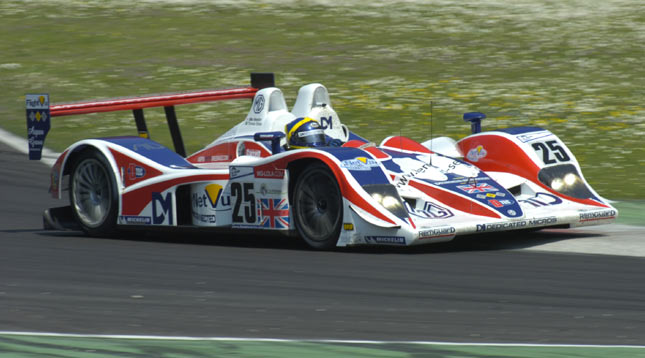
By
five-fifteen it was possible to calculate how much of the
race remained. The expected total number of laps was 173.
The leader; at that stage Marc Gene in the #7 Peugeot 908,
has just completed his 142nd. That left thirty laps of the
race left to run at an average pace of around 1 minute 40
seconds per lap, or the equivalent of some 50 minutes' racing.
Jean-Christophe Bouillion was lying second in the #16 Pescarolo,
just a lap adrift of the leading Peugeot.
In
the MG pits, a close eye was being kept on the telemetry.
The frequency of necessary pitstops was increasing, and
had now dropped to once every eight to ten laps. The next
came at 5:18, but with the third-placed car – now
the Binnie Lola once again – more than a dozen laps
behind, the decision was taken to press on, rather than
attempt any repair. “It was very frustrating, but
I think it was better to play safe rather than risk the
engine,” said Phil Barker. “I was just watching
the water temperature all the time.”
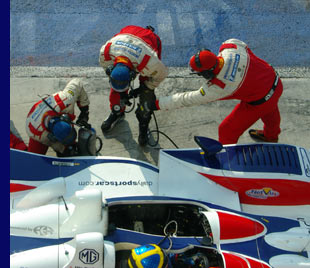 Almost
any other team in the race would have had to pull their
car out of the race if faced by a problem like the one RML
was coping with so admirably, and all thanks to forethought
and planning. The team has consistently worked on preparing
the MG for endurance races, and most significantly, the
Le Mans 24 Hours. Built into the engineering of the car
are many safeguards and systems whose sole purpose is to
ensure that the car can be kept going, come what may. Twin
alternators and paired starter-motors are just two of the
better-known provisions for reliability, but the team now
revealed a third. The engine cooling system on the MG can
be replenished in seconds without having to remove the engine
cover. The hose from a pressurized canister of coolant can
be plugged into a special docking port on the side of the
car. A built-in relief valve allows the fluid to be forced
into the system under pressure, with excess coolant being
rejected as soon as the optimum level is achieved. In a
matter of seconds, the entire system can be flushed and
refilled, and at Monza this allowed the MG to continue racing
with the minimum loss of time.
Almost
any other team in the race would have had to pull their
car out of the race if faced by a problem like the one RML
was coping with so admirably, and all thanks to forethought
and planning. The team has consistently worked on preparing
the MG for endurance races, and most significantly, the
Le Mans 24 Hours. Built into the engineering of the car
are many safeguards and systems whose sole purpose is to
ensure that the car can be kept going, come what may. Twin
alternators and paired starter-motors are just two of the
better-known provisions for reliability, but the team now
revealed a third. The engine cooling system on the MG can
be replenished in seconds without having to remove the engine
cover. The hose from a pressurized canister of coolant can
be plugged into a special docking port on the side of the
car. A built-in relief valve allows the fluid to be forced
into the system under pressure, with excess coolant being
rejected as soon as the optimum level is achieved. In a
matter of seconds, the entire system can be flushed and
refilled, and at Monza this allowed the MG to continue racing
with the minimum loss of time.
Finish
At
5:31 the #27 Horag Lola made what would be its final pitstop
of the race. Just 20 laps remained. Tommy continued to circulate
strongly, consistently setting times in the low 1:44s, and
occasionally dipping into the forty-threes. By doing so,
he was slowly clawing back the deficit on the Horag Lola,
but with a full three laps to recover, it was evident that
only major problems for the leader could now prevent the
Swiss team from securing victory. The Binnie Motorsports
Lola, #31, retained third in LMP2, running 23rd overall
but 15 laps adrift. At ten to six the Rollcentre Pescarolo
pitted from 6th position, and this allowed the untroubled
#27 Lola to move ahead. Erdos followed the LMP1 car down
the pitlane moments later for the briefest of pauses while
the coolant levels were checked and refilled once again,
but between whiles his average lap times remained unaffected.
With only half a dozen laps remaining, this would be the
MG’s final stop.
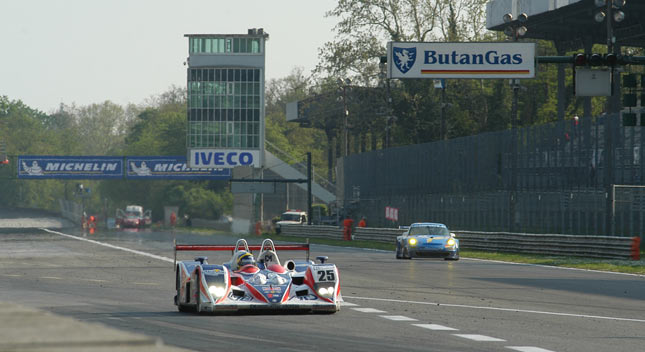
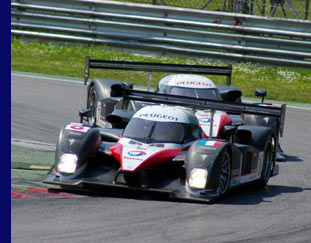 At
6:04 the chequered flag fell upon a historic maiden victory
for the new Peugeot 908; Marc Gene crossing the line at
the end of 173 laps, one lap clear of the #16 Pescarolo.
The second Peugeot, #8, had recovered very strongly, thanks
largely to Stephane Sarrazin, who had been lapping even
quicker than the winning car in his determination to reach
the podium. It was an impressive showing from the debutant
diesel, and perhaps offers just a hint of the car’s
true potential. Perhaps there will be a “race”
at Le Mans in June!
At
6:04 the chequered flag fell upon a historic maiden victory
for the new Peugeot 908; Marc Gene crossing the line at
the end of 173 laps, one lap clear of the #16 Pescarolo.
The second Peugeot, #8, had recovered very strongly, thanks
largely to Stephane Sarrazin, who had been lapping even
quicker than the winning car in his determination to reach
the podium. It was an impressive showing from the debutant
diesel, and perhaps offers just a hint of the car’s
true potential. Perhaps there will be a “race”
at Le Mans in June!
In LMP2, the class win went, perhaps a little unexpectedly,
to the Swiss Horag Racing squad, their Lola B05/40 running
faultlessly throughout. Their achievement was made all the
more commendable when it was revealed that the car had been
shipped straight from America to Monza, and had only arrived
on Thursday, “fresh” from the Sebring 12 Hours
in mid-March. Second for the RML MG EX264 was not, perhaps,
what the team had hoped for after running so strongly for
the first three hours, but a worthy reward for ingenuity
and skill. The Binnie Motorsports Lola finished third, despite
early problems, to offer Lola a clean-sweep in LMP2, the
Saulnier Courage ending the day in fourth.
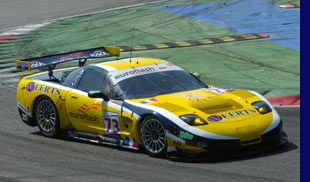 In
GT1, victory went to the #72 Corvette C6R of Luc Alphand
Adventures, with the #50 Labre Aston Martin second and the
#73 Corvette C5R third. To have both his Corvettes on the
podium was some recompense for Luc Alphand’s traumatic
Friday, and a fitting reward for a team that worked to hard
to rebuild the burnt-out C5R after the chances had looked
almost impossible. Top honours in GT2 to the #97 GPC Motorsport
Ferrari, with further 430s in second and third, and the
#81 LNT Panoz fourth. The Porsches were nowhere at Monza,
with the best effort being sixth for the IMSA Performance
997.
In
GT1, victory went to the #72 Corvette C6R of Luc Alphand
Adventures, with the #50 Labre Aston Martin second and the
#73 Corvette C5R third. To have both his Corvettes on the
podium was some recompense for Luc Alphand’s traumatic
Friday, and a fitting reward for a team that worked to hard
to rebuild the burnt-out C5R after the chances had looked
almost impossible. Top honours in GT2 to the #97 GPC Motorsport
Ferrari, with further 430s in second and third, and the
#81 LNT Panoz fourth. The Porsches were nowhere at Monza,
with the best effort being sixth for the IMSA Performance
997.
After
running so strongly throughout the first three hours, the
RML team might have been forgiven for feeling disappointed
by second at the flag, but in reality, this was an excellent
result for the Wellingborough-based outfit. “It was
very frustrating to develop the water leak, and that blighted
us for the rest of the race,” said Phil Barker. “The
high temperatures and fast pace turned this into a race
of attrition, and it was there for us to pick up the pieces.
Here, our Le Mans preparations paid dividends, and we have
the systems to look after the car and get us home. In the
end, though, races are won by drivers, and if there are
problems, it’s down to the good drivers to work around
them. Mike persevered with his vibration long after others
would have given up, and he drove through it and out the
other side. That’s the sign of a good driver. Then
Tommy put in a perfect performance to bring the car safely
through to the end. Yes, it was frustrating to have the
problem, but very satisfying to have finished second. Compared
to this time last year, I’m feeling very much happier!
We’ve taken eight points today, and that’s purely
down to luck and good preparation.”
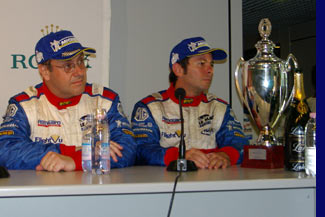 Tommy,
interviewed during the post-race press conference, also
alluded to the quality of RML’s preparation. “We’re
delighted with the result. We knew we faced a lot of competition
this year, racing against good drivers and good teams, but
we focused on preparation for the race, not qualifying,
and it paid off.” After two days of difficult practice,
he also looked back on the apparent (but subsequently unsubstantiated)
lack of pre-race pace. “If someone had said three
or four days ago that we might finish third or fourth, we’d
have taken it.” Maybe finishing second was better
than many had expected then? “Yes, but we had the
pace to beat them all today,” countered Erdos. “We
had a really good race car. We were leading, we had the
pace, and we had the chance to win. Then we encountered
the problem. It was so frustrating! The team managed the
issue so well and kept us on the track. There was no point
in taking risks, and it paid off. We’ve got points
in the bag, and our closest rivals for the title didn’t
score any. That’s the perfect start for us, so no
complaints. Even so, we genuinely thought we could have
won today.”
Tommy,
interviewed during the post-race press conference, also
alluded to the quality of RML’s preparation. “We’re
delighted with the result. We knew we faced a lot of competition
this year, racing against good drivers and good teams, but
we focused on preparation for the race, not qualifying,
and it paid off.” After two days of difficult practice,
he also looked back on the apparent (but subsequently unsubstantiated)
lack of pre-race pace. “If someone had said three
or four days ago that we might finish third or fourth, we’d
have taken it.” Maybe finishing second was better
than many had expected then? “Yes, but we had the
pace to beat them all today,” countered Erdos. “We
had a really good race car. We were leading, we had the
pace, and we had the chance to win. Then we encountered
the problem. It was so frustrating! The team managed the
issue so well and kept us on the track. There was no point
in taking risks, and it paid off. We’ve got points
in the bag, and our closest rivals for the title didn’t
score any. That’s the perfect start for us, so no
complaints. Even so, we genuinely thought we could have
won today.”
“Coming
away with eight points gives us a valuable buffer,”
added Mike Newton. “We hope we can finish on the podium
each race, and this start to the year really keeps the championship
alive for us – and it’s so much better a start
to the season than last year! Maybe we deserved a run of
better luck, and perhaps today, we got it.”
Adam
Wiseberg, who does so much behind-the-scenes work to keep
the race programme going, was over the moon. “I’m
absolutely delighted,” he said. “Second place
in the first race of the new season is a far better start
to the year than 2006. We’ll treasure those points.
It’s a good job all round, and there’s no point
in worrying over what might have happened. The drivers,
both of them, did a wonderful job, and without the leak,
we’d have won today, but it’s a great start
to the season all the same.”
A
gallery of high resolution images can be found here.
Photography by Marcus Potts. Selected additional photos
on this page kindly supplied by David Lord of Dailysportscar
and David Stephens of Studio 21.
During
the race, "live" reporting was offered on the
website, with events being described as soon as they had
happened on the track. To view this archive, click here.
